This was published 8 years ago
Ubud Food Festival: cooking up a storm in Bali
By Jacqui Taffel
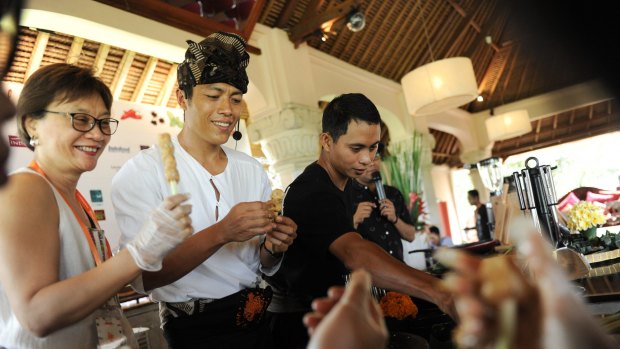
Ubud chef Made Lugra makes sate lilit, a popular local seafood sate, with his audience.Credit: Anggara Mahendra
I'm standing in a cool, dim bathroom plastered neck to toe in a scrub made of ground rice. The brisk Balinese masseuse is now slathering me in yoghurt. She has already prepared a bath strewn with petals – rose, frangipani, bougainvillea – but I'm worried it's not going to be very pleasant once it's full of yoghurt and rice.
Fortunately, I am instructed to wash off the yoghurty crust in the shower before stepping into the bath. This treatment using edible ingredients, said to be for primping Javanese princesses, seems a fitting way to prepare for three days at the inaugural Ubud Food Festival.
Stamina is needed, and a large appetite, to do justice to the profusion of events all over the small Balinese town and beyond, from cooking masterclasses to food photography workshops, coffee plantation tours to intimate glimpses into private family compounds. Then there's the hotly contested beef rendang cook-off between Malaysia and Indonesia, and a Mad Hatter's Tea Party with local ingredients starring in newly invented cakes and sweets such as pandan kaya ice-cream, tiramisu with clove cream and kaffir lime madeleines. Willy Wonka would be proud.
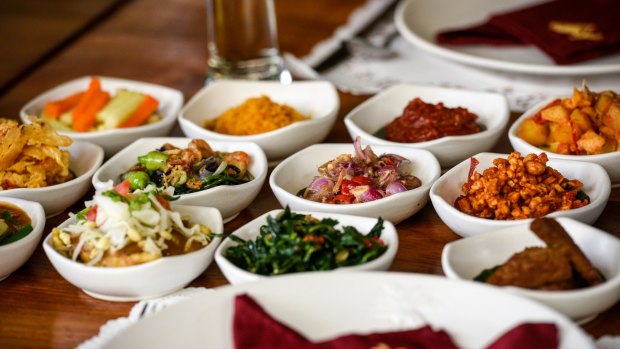
Padang-style or rijsttafel lunch at Warung Pulau Kelapa.Credit: Jacqui Taffel
The festival is organised by local identity Janet DeNeefe, who moved from Melbourne to Ubud after marrying a local man. In 2004, she started the Ubud Readers and Writers Festival, which is split roughly 50-50 between overseas and Indonesian guests. DeNeefe is proud that the food festival is 90 per cent Indonesian. A running theme, discussed by local chefs, food writers and audience members, soon emerges. Why is the enormously diverse food of this island archipelago is not more widely known overseas, compared to Chinese, Thai, Vietnamese or Malaysian? Much discussion revolves around this question and how to boost the country's culinary presence.
A newcomer to Bali, I am smitten by pretty much everything I taste, at the festival and in Ubud's restaurants, cafes and warungs. On my first evening, at a touristy restaurant specialising in Belgian food near my hotel, I cautiously order the dullest thing on the menu, vegetarian fried rice. Expecting an ordinary pile of rice and veg, I am startled when the dish arrives on a long white plate with many small elements beautifully presented – a moulded martello tower of yellow rice (which I discover later is called tumpeng, or mountain of life) topped with a fried egg, carefully arranged slices of tofu and tempeh, pickled vegetables, garlic crackers, salad, chilli sauce and lots of vegetables.
I flip from feeling slightly sheepish at such a boring choice to delighted. This is repeated almost everywhere I go: simple dishes presented with care and generosity. At the other end of the scale is the delicate and ingenious degustation menu at Restaurant Locavore, where two chefs, Dutch expat Eelke Plasmeijer and Indonesian Ray Adriansyah, work with a local kitchen crew to transform Bali's seasonal ingredients. It's hard to get a booking, and I squeeze in at the last minute at the bar, but it turns out to be a good spot to observe the kitchen in action.
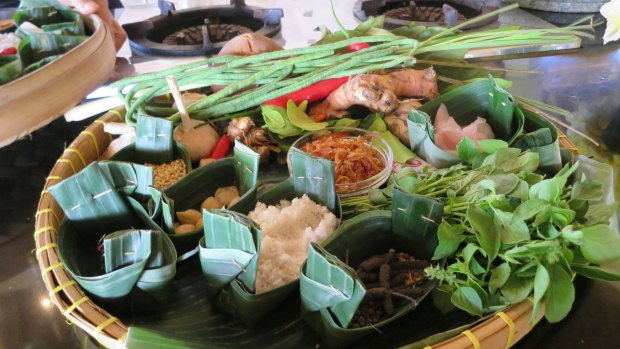
Ingredients at cooking demonstration, Ubud Food Festival.Credit: Jacqui Taffel
Again, the simplest things become surprising, like the dessert made with cucumber sorbet, pickled cucumber and cucumber juice. At the festival, Plasmeijer demonstrates Locavore's langouste dish. The lobster-like shellfish, caught in Balinese waters, is poached in cacao butter with vanilla from Ubud and seaweed from Lombok. Then there's a tangerine reduction made from local fruit, artful shavings of cauliflower grown nearby, and a garnish of tarragon leaves and flowers from the restaurant's own garden. The dish tastes like eating the sea – sea with a delicate cauliflower flavour.
I am left puzzling over the question: why does Indonesian food have a relatively low profile overseas? Particularly in Australia, its closest neighbour with a sophisticated multicultural palate.
One theory keeps coming up. When the country was founded in 1945, it roped together a disparate collection of island states, each with distinct cultures, traditions, languages and food. To complicate things further, the same dish can vary greatly on the same island, from the coast to the inland, or even from one village to the next.
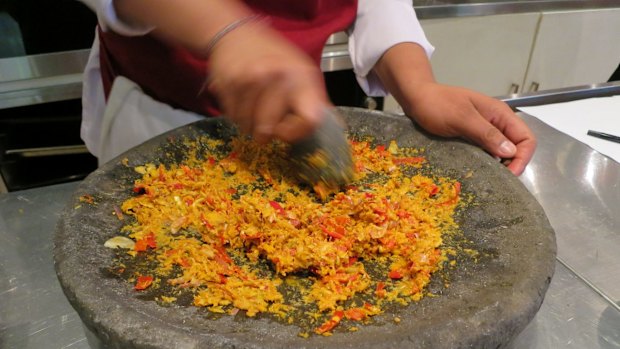
Making Balinese spice mix (bumbu) at Mosaic restaurant in Ubud.Credit: Jacqui Taffel
Festival guest Bondan Winarno, a Jakarta-based food writer who has travelled the country comparing regional cuisines and where to find the best of each dish, says even the coconuts taste different, depending on where they are grown.
"How can we bring this diversity and deliciousness to the world?" he asks. "I have eaten Indonesian food overseas, from Melbourne to LA, and nearly cried, it was so bad."
He believes there is a need for standardised Indonesian dishes, like other Asian cuisines such as Thai – order pad Thai or tom yang goong and you know pretty much what you're getting.
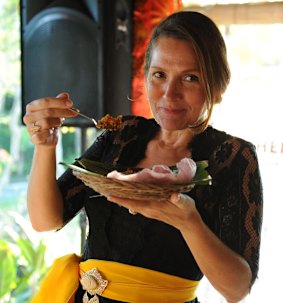
Janet DeNeefe, who started the Ubud Food Festival in 2015. Credit: Anggara Mahendra
Professional Indonesian chefs often don't learn to cook their own cuisine. Ubud chef Made Lugra trained in everything from French and Italian to Mexican, and has worked with Australian chefs, but he has only recently put Balinese dishes on the menu at the local tourist resort where he heads the kitchen. "We go to the local market first before we create the menu, it's what we can get fresh every morning," he says.
For his festival demonstration he makes sate lilit, a popular local seafood sate, the traditional way. He pounds white fish, prawns and spices in a large bucket-sized mortar with long wooden pestle used standing up, the way his mother taught him. The mixture is then moulded around sticks of lemongrass – the audience gets to have a go, with the chef giggling at some of the lumpier results – then cooked over a simple grill. Everyone gets a taste in small bowl made of banana leaves, with a banana leaf spoon to scoop up the rice underneath.
Another festival theme is the most important element in Balinese cooking: bumbu, a mixture of roots, spices and aromatics ground by hand, which varies from dish to dish, person to person.
During a two-hour masterclass at Mozaic restaurant with chef Chris Salans, who landed in Bali 20 years ago from the US via France, we learn how to make a classic basa gede mix. It involves pounding 15 ingredients in a mortar and pestle, including two kinds of galangal and chilli, candlenuts, shrimp paste and salam leaf, then frying the paste slowly for a full hour before it's ready to use.
In different sessions the same question keeps coming up - can you use a blender to make these pastes rather than grinding in a mortar and pestle? Each time the answer is the same: you can use a blender, but it won't taste the same.
"If you blend, it just cuts the ingredients," chef Lugra explains. "If you press it, all the juices come out."
The festival's enthusiastic audience is part of the fun. They come from all over South-East Asia, from Singapore, Malaysia and the Philippines, as well as Indonesia and Australia, and there are lots of young faces.
Because Ubud is a small town, festival-goers bump into each other on the street and get to know each other at shared events. On the final day, I'm sitting with Amaliah, a social policy researcher from Yogyakarta who also happens to be the city's Slow Food representative and has written a cookbook in her spare time.
We are at Warung Pulau Kelapa for a padang-style or rijsttafel lunch, where more than 25 small serves of different dishes are set before us. Traditionally this kind of meal is like a smorgasboard, where diners help themselves to what they want; what they don't eat returns to the kitchen to be served again. Here, the food is cooked to order and not recycled. Some dishes have become familiar in my time at the festival, such as the sate lilit, five kinds of sambal, tempeh and rendang.
However most of the dishes are unfamiliar, and Amaliah patiently answers questions about each one from me and others at our table.
We also get a taste of Ubud's famous babi guling, the local suckling pig with its fantastically tender meat faintly coloured with turmeric, and glass-like shards of crackling, like delicate toffee. We have already seen how it is made during an early morning tour that gives us an intimate glimpse into the private family compounds where Ubud's signature dishes are prepared, including bebek betutu (smoked duck) and betutu ayam (braised chicken).
At the babi guling compound we see the suckling pigs prepared, stuffed with bumbu then turned on a spit by hand for more than three hours in fiery cooking pits that look like a cross between a medieval dungeon and hell.
Last but not least, it's time to sit down at a long, playfully decorated table for the Mad Hatter's Tea Party, a two-hour sugar bonanza hosted by local pastry chef Angelita Wijaya and Singapore star Janice Wong, famed for the intricate, boundary-pushing creations at her 2am: Dessert Bar. Wong comes to Bali regularly to de-stress and do yoga, but her food festival appearances are the first time she has cooked with local ingredients. She has purposely brought nothing with her, to invent new dishes from scratch. This is a challenge for her, a self-confessed control freak, but rewarding.
She plans to use some of the ingredients she has found here – raw cacao paste, freshly pressed coconut oil – when she returns to her usual frenetic pace in Singapore.
For the second Ubud Food Festival in May 2016, the focus has stayed firmly on Indonesia, with a "Go Local" theme looking at food in its natural context, including local producers, ingredients and traditions. DeNeefe was keen to rope in some of Ubud's grandmothers this year, the keepers of traditional culinary wisdom, to pass on their skills and knowledge to younger generations and share their secrets. The program includes a tour to visit the "Tofu Grannies" who have made artisan tofu in Ubud for generations. It will also continue to explore the transformation of Indonesian food, locally and overseas. "How do we modernise and keep our traditional roots?" DeNeefe says. "That's what this year's festival is all about."
Ubud Food Festival, May 27-29, 2016, ubudfoodfestival.com.
TRIP NOTES
MORE INFORMATION ubudfoodfestival.com
GETTING THERE Virgin, Qantas, Jetstar and Garuda all fly direct to Denpasar. A taxi from Denpasar airport to Ubud takes about an hour, depending on traffic.
STAYING THERE Ubud has hotels, guesthouses and resorts to suit any budget. Bisma Eight is a boutique resort, which opened last year and is quite close to many festival venues (it hosted the Mad Hatter's Tea Party). Its infinity pool and many of the rooms look over the steep, jungly river valley. The Garden Suites don't have this view, but are very spacious and well-appointed. See bisma-eight.com.
EATING THERE On the same road as Bisma-Eight, Cafe des Artistes specialises in Belgian food (it was set up by a Belgian) but the Indonesian dishes are good too. See cafedesartistesbali.com.
You need to book well ahead for Restaurant Locavore, but it's worth the effort. If you miss out, you can go to sandwich shop across the road, Locavore To Go. See restaurantlocavore.com.
Seniman Coffee Studio does good caffeine, with beans from Bali and around the world, and is a pleasant place to sit and digest for a while. See senimancoffee.com.
Jacqui Taffel travelled as a guest of the Ubud Food Festival.
Sign up for the Traveller Deals newsletter
Get exclusive travel deals delivered straight to your inbox. Sign up now.